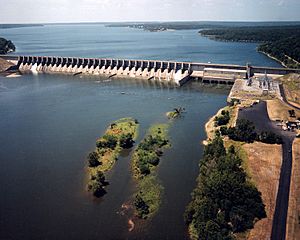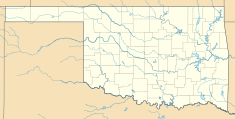Fort Gibson Dam facts for kids
Quick facts for kids Fort Gibson Dam |
|
|---|---|

Fort Gibson dam seen from above
|
|
|
Location of Fort Gibson Dam in Oklahoma
|
|
| Country | United States |
| Location | Wagoner / Cherokee counties near Fort Gibson and Okay, Oklahoma, US |
| Coordinates | 35°52′11″N 95°13′50″W / 35.869665°N 95.230436°W |
| Status | In Use |
| Construction began | 1941 |
| Opening date | 1949 |
| Construction cost | $22,000,000 |
| Owner(s) | U.S. Army Corps of Engineers |
| Dam and spillways | |
| Type of dam | Concrete Gravity |
| Impounds | Neosho River |
| Height | 110 ft (34 m) |
| Length | 2,850 ft (869 m) |
| Spillways | 30 |
| Spillway type | Tainter gate |
| Spillway capacity | 986,000 cu ft (27,920 m3) |
| Reservoir | |
| Creates | Fort Gibson Lake |
| Total capacity | 1,292,000 acre⋅ft (2 km3) |
| Active capacity | 1,287,000 acre⋅ft (2 km3) |
| Catchment area | 12,615 sq mi (32,673 km2) |
| Power station | |
| Commission date | 1953 |
| Turbines | 4 x 11.25 MW Francis-type |
| Installed capacity | 48 MW |
| Annual generation | 208,482,000 KWh |
The Fort Gibson Dam is a large structure built on the Grand (Neosho) River in Oklahoma. It's located about 5.4 miles (8.7 km) north of the town of Fort Gibson. This dam helps create a big body of water known as Fort Gibson Lake.
The main reasons for building the dam and lake were to control floods and to produce hydroelectric power. This means it uses the force of water to make electricity. The project also provides drinking water to local communities and offers many fun activities like boating and fishing.
The idea for the dam was approved in 1941, and construction began the next year. Work was paused during World War II but started again in May 1946. By June 1949, the river was closed off. The entire project was finished in September 1953 when the last of the power plant's four generators began working.
Contents
About the Fort Gibson Dam
The Fort Gibson Dam is a type of structure called a gravity dam. This means it's so heavy and thick that its own weight holds it in place against the force of the water. The dam is owned and operated by the U.S. Army Corps of Engineers.
Dam Structure and Size
The dam is made mostly of concrete. It stands about 110 feet (34 meters) tall. The top of the dam stretches for about 2,850 feet (869 meters) across the river.
To help the dam hold back water, there are also three large earth-filled walls called dikes. These dikes are up to 18 feet (5.5 meters) tall and have a total length of about 8,500 feet (2,591 meters). They help extend the barrier created by the main dam.
Water Levels and Pools
The dam manages different water levels, which are measured above sea level.
- The very top of the dam is at 593 feet (181 meters).
- The top of the gates that control water flow is at 582 feet (177 meters).
- The spillway crest, where water would naturally flow over if gates were closed, is at 547 feet (167 meters).
- The normal "power pool" level, used for making electricity, is at 554 feet (169 meters).
- The "flood control pool" can hold water up to 582 feet (177 meters) during heavy rains to prevent flooding downstream.
Spillway System
The dam has a special section called a spillway. This is where excess water can be safely released from the lake. The Fort Gibson Dam's spillway has 30 large Tainter gates. Each gate is 40 feet (12 meters) wide and 35 feet (11 meters) tall.
The spillway is about 1,490 feet (454 meters) long. It can release a huge amount of water, up to 915,000 cubic feet per second (25,900 cubic meters per second), especially when the lake is at its highest level during floods.
Outlet Works
Besides the spillway, the dam also has 10 smaller openings called sluices. These are 5 feet 8 inches (1.7 meters) by 7 feet (2.1 meters) in size. They can release water at a rate of up to 20,800 cubic feet per second (590 cubic meters per second). These are used to control water flow for other purposes, like maintaining river levels below the dam.
Fort Gibson Lake (Reservoir)
The lake created by the dam is called Fort Gibson Lake. It's a very large reservoir.
- When the water is at the top of the gates, the lake holds about 1,287,000 acre-feet (1.59 billion cubic meters) of water.
- At its absolute maximum, the lake can hold up to 1,292,000 acre-feet (1.6 billion cubic meters) of water.
- The area that drains into the lake, called the drainage area, covers a huge 12,615 square miles (32,673 square kilometers).
Making Electricity
The Fort Gibson Dam is an important source of hydroelectric power.
- The power plant started operating in 1953.
- It has four large turbines, each capable of producing 11.25 megawatts (MW) of power.
- In total, the plant can generate 48 MW of electricity.
- Each year, it produces about 208,482,000 kilowatt-hours (KWh) of electricity. This is enough to power many homes and businesses!


